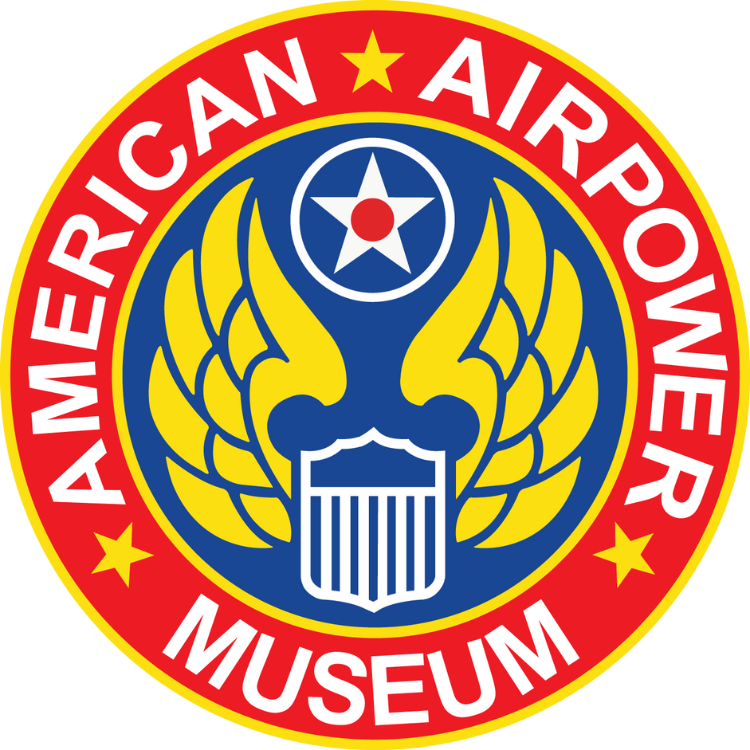Honor Flight Volunteer Eric Wieboldt Sings his heartfelt original song- “Welcome Home, My Brother” for Veterans at the 2024 Honor Flight Veterans Reunion at the American Airpower Museum
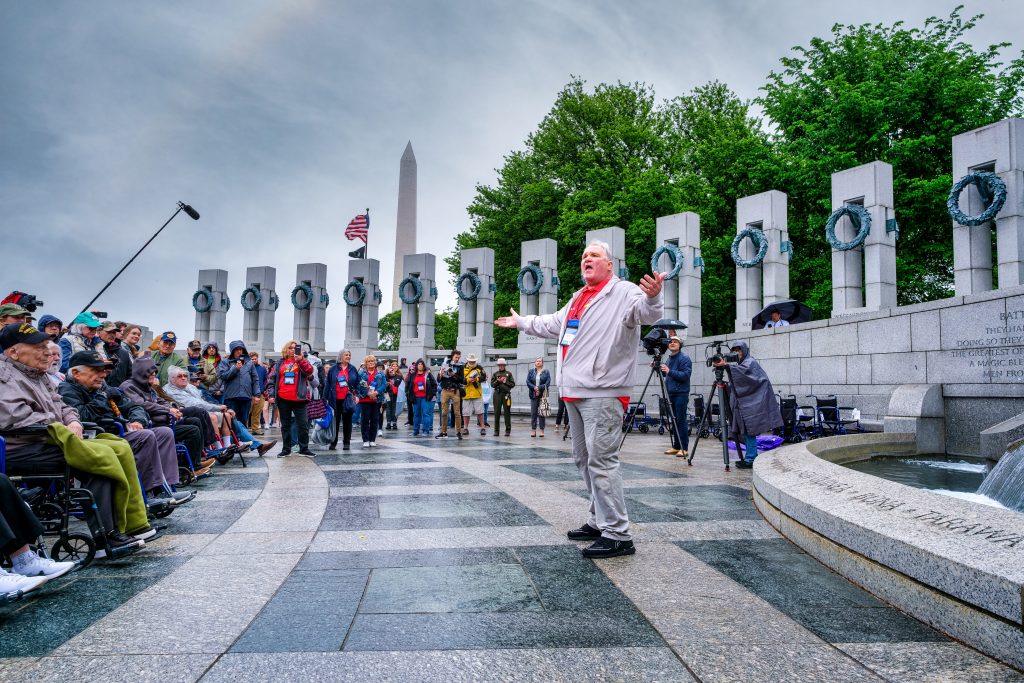
Heartfelt Original Song tribute by Honor flight volunteer Eric Wieboldt- “Welcome Home, My Brother” – written and performed for Long Island’s Vietnam War Veterans at Veterans Reunion at the American Airpower Museum August 3rd 2024 Long Island’s Vietnam War Veterans received a special honor on May 4, 2024, during their visit to Washington, D.C. sponsored by Honor Flight Long Island. A heartfelt musical performance was given by Eric Wieboldt, a long-time Honor Flight volunteer and Guardian. Despite the pouring rain, Eric performed his original song titled “Welcome Home, My Brother,” which caused many tearful eyes in the dozens of Veterans and onlookers present. In anticipation of being a Guardian on the May 4th Honor Flight to D.C., Eric was inspired to write his song, a prayer really, called “Welcome Home, My Brother.” This is because our Vietnam Veterans never received a proper welcome home. His song is an attempt to right that wrong. Eric is grateful to Honor Flight Long Island for including him in their continued efforts to support and pay tribute to our Veterans. Many Honor Flight officials, as well as Veterans’ families and onlookers, were on hand for his moving performance. “Eric’s song honored the cohort of Vietnam Veterans that Honor Flight brought to D.C. on May 4th,” said Bill Jones, President, Honor Flight Long Island, U.S. Army Veteran and West Point Graduate. “His song was part of our ongoing efforts to give long overdue recognition and thanks for their service. Honoring our Vietnam Vets means a lot to these guys, even after all these years,” Jones said. Eric was born in 1957, grew up in Levittown and now lives in Merrick. During 2014, Eric shared his first Honor Flight mission as a Guardian for his father, the late World War II Veteran Robert Wieboldt of the U.S. Army Air Corps. During the pandemic, Eric sang at many “drive-by” Centenarian Veterans’ birthday parties and the Phoenix Rising Award Ceremony honoring local Veterans’ groups and individuals. In partnership with Honor Flight Long Island, Eric is launching a nation-wide campaign to bring the message of his comforting and emotionally powerful song to millions of Americans. Eric Performed his original song once again for the veterans and their families gathered for the 2024 Honor Flight Veterans Reunion this past August 3rd 2024 at the American Airpower Museum. The song, and is performance was a moving tribute for the veterans and had all in attendance standing in tribute led by the veterans in attendance. Eric is honored to perform his copyrighted song by special request to Honor Flight. Interested parties please contact Bill Jones at (631) 276-8825 or ddbeach5@gmail.com. Enjoy both the recorded song, and a video from the performance provided by local videographer Chris Lauterbach available below:
American Airpower Museum Volunteer and Historian Honors Aviation Pioneer Jacqueline Cochran and founder of WWII Women’s Air Service Pilot Corps at Long Island Aviation Hall of Fame induction
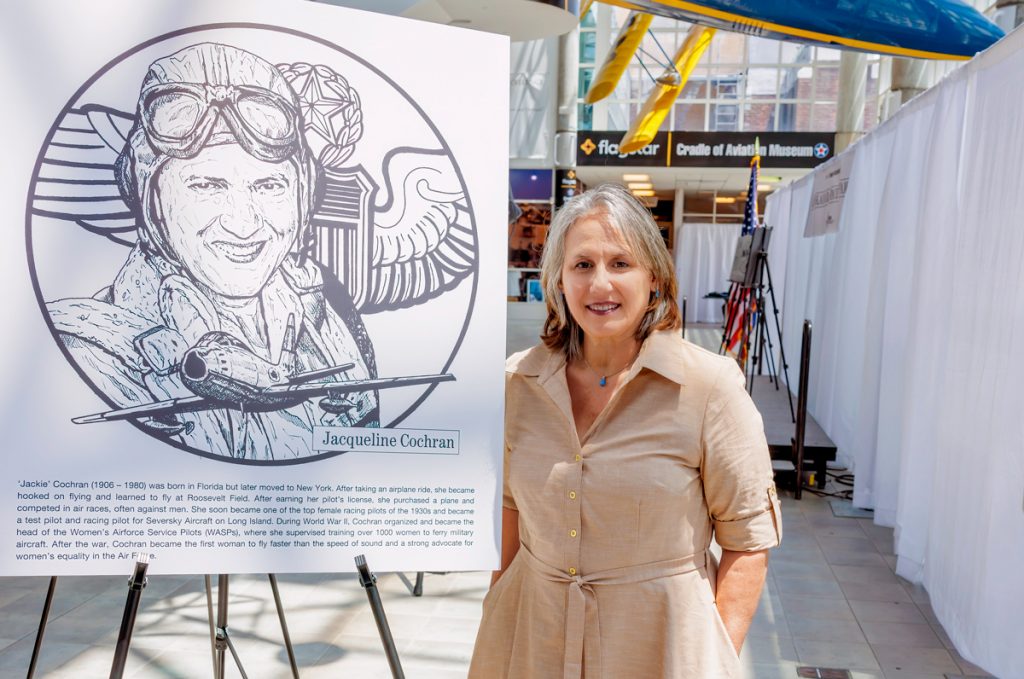
https://metroairportnews.com/aviation-pioneer-jacqueline-cochran-inducted-into-the-long-island-aviation-hall-of-fame/
Featured by News 12 LI the American Airpower Museum Warbirds honor Veterans Past and Present during Jones Beach Air Show 2024
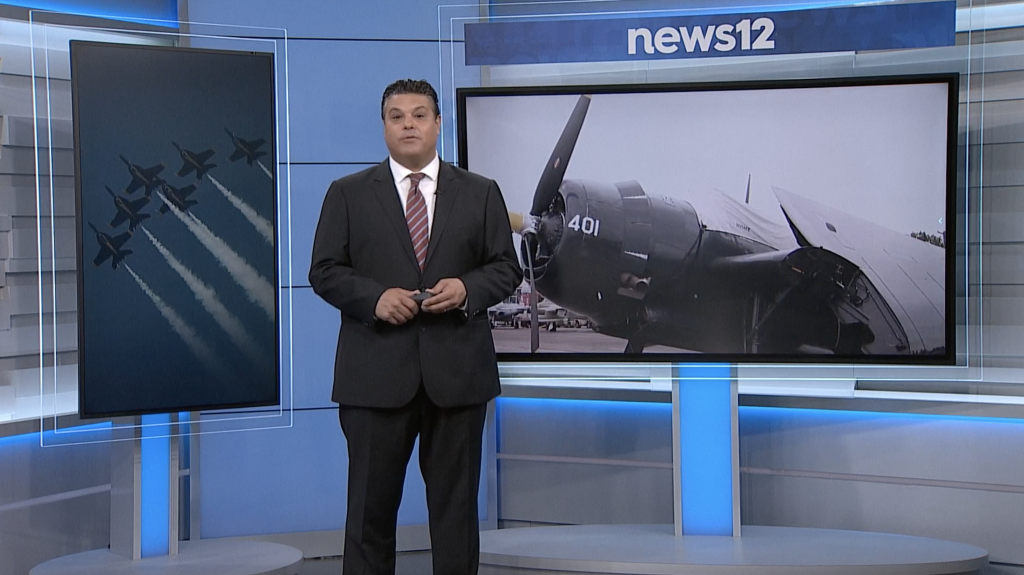
Thank you to News 12 LI for featuring us in their coverage of the past Memorial Day Weekend’s Bethpage Jones Beach Air Show Coverage! I was an honor to honor our veterans and all those who worked in Long Island’s Defense Industry since WWII. We also had the chance to say goodby to the A-10 Demo Team as they perform for their final year prior to disbanding ahead of the A-10’s retirement from USAF Service. https://longisland.news12.com/preparations-underway-for-bethpage-air-show-at-jones-beach Our Warbirds flew Friday through Sunday for the show’s operations and also were on display and flew for our visitors at the museum at Republic Airport in Farmingdale, NY. We had a great weekend flying for our hometown Long Island / New York Crowds.
Vietnam 50th Anniversary Veterans Medal Ceremony at the American Airpower Museum
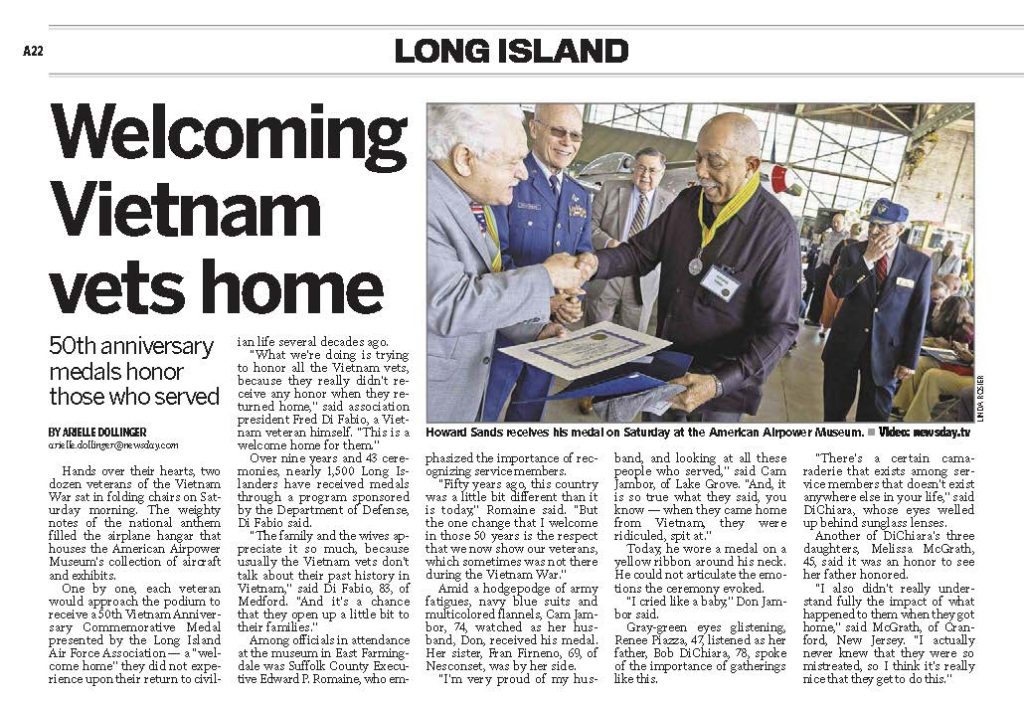
May 11th, the American Airpower Museum hosted the Vietnam 50th Anniversary Veterans Medal Ceremony presented by the Long Island Chapter of the Air Force Association. The event was covered and featured by our local sponsor Newsday!
Honoring the Pioneering 555th Parachute Infantry Battalion of WWII
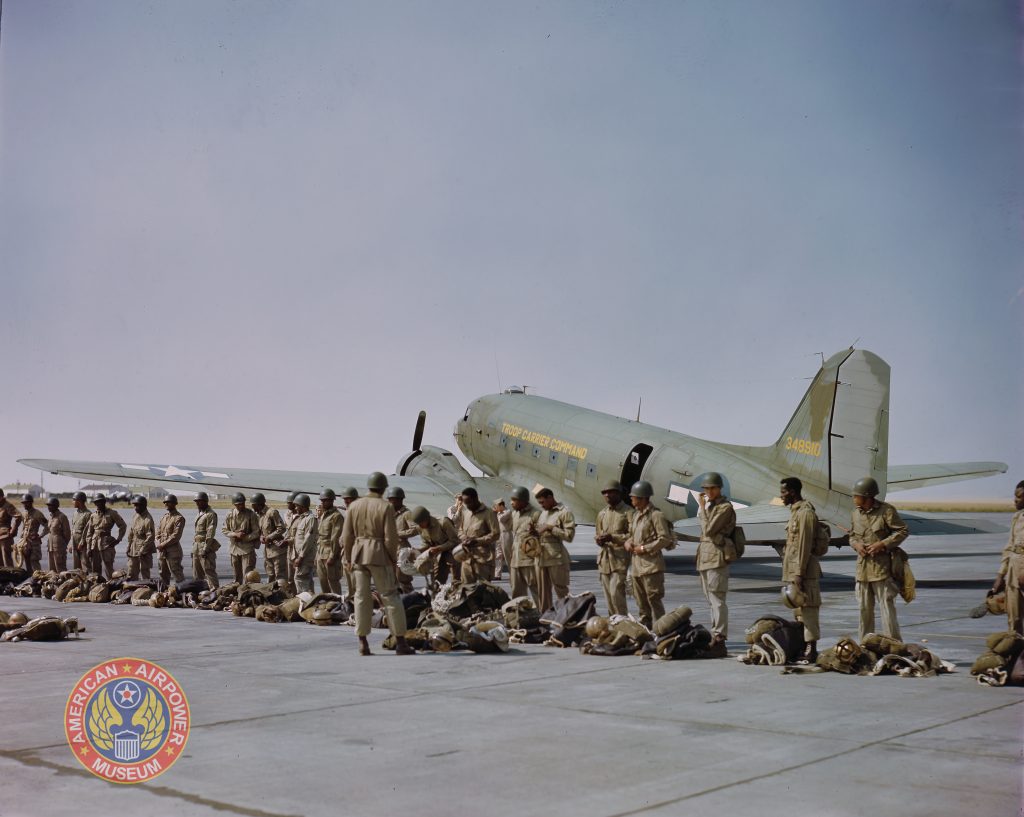
This past February the American Airpower Museum honored the pioneering 555th Parachute Infantry Battalion, the first all black airborne battalion during World War Two. The unveiling began with an educational presentation by museum volunteer and living historian Nick Casseus on the formation and operational achievement of the “Triple Nickel” as the unit became known. The following are great articles as featured in the news following the events. As featured in American Airpower Museum Sponsor NEWSDAY on February 25th: Another great article describing the event by Lauren Feldman of Anton Media group as featured in the Nassau Observer:
American Airpower Museum and Nassau County Barry Tech BOCES Prepare HS Students for Aviation Careers
American Airpower Museum and Barry Tech Prepare HS Students for Aviation Careers Farmingdale, NY, January 8, 2024 – American Airpower Museum is partnering with the Nassau BOCES Joseph M. Barry Career and Technical Education (CTE) Center, offering internships for local high school students pursuing various careers in aviation. One example is the current internship program for Aviation Operations Teacher Evan Damadeo’s afternoon classes of graduating seniors. Mr. Damadeo’s students intern every Thursday and Friday afternoon for a full year at American Airpower Museum (AAM) at Republic Airport. His students are responsible for maintaining the Museum’s military aircraft by cleaning and waxing them. They also learn about aircraft mechanical systems and aviation history while working at the Museum. Barry Tech’s industry partner Lawrence Starr, Museum Manager, has mentored Barry Tech high school student interns at AAM for 10 years! Mr. Damadeo graduated with a Bachelor of Aeronautical Science Degree from Embry-Riddle Aeronautical University, where he obtained his Commercial Single and Multi-Engine Instrument Airplane Rating, plus a Certified Flight Instructor-Instrument while completing college. He is also Chief Flight Instructor and General Manager of a local Fixed Based Operator located on Long Island since 2015. Shown in the attached photograph are (Left to Right) student interns Dylan McConn (Port Washington UFSD), student intern Ashton Heeralal (Valley Stream CHSD), American Airpower Museum Volunteer Steve Korin, student intern Liam Reynolds (Oceanside UFSD), and student intern Alex Rosenkrantz (East Meadow UFSD). They are standing in front of the Museum’s WWII Douglass B-25 Mitchell Bomber. Other Barry Tech courses prepare students for the Federal Aviation Administration Private Pilot Written Exam, plus provide aircraft flight training that can be credited toward a Private Pilot License. Some students supplement their flight training at Republic Airport with private lessons enabling them to complete their first solo flight and earn their Private Pilot License while still in high school! Barry Tech of Westbury is a CTE center for 11th and 12th grade students from Nassau schools. Aside from Aviation Operations, other internships cover Automotive Repair, Carpentry, Computers, Cosmetology, Criminal Justice, Culinary Arts, Dental Assistant, Fashion Design, HVAC/Plumbing, Law Enforcement and Nursing, among others. After a two-year internship, students receive certificates and pursue part and/or full-time jobs, or even college, based on their excellent Barry Tech educational experience. If you are a business who would like to partner with Barry Tech, take their students as interns or hire them, please contact Lauren Engels, Work-Based Learning Coordinator, at (516) 622-6864, and/or email lengels@nasboces.org. If your son/daughter is interested in attending one of Barry Tech’s career and technical education CTE programs, please have them speak with their High School Guidance Counselor for more information. As featured in: https://theisland360.com/community-news/american-airpower-museum-and-barry-tech-prepare-high-school-students-for-aviation-careers/ The American Airpower Museum is an aviation museum located on the landmarked former site of Republic Aviation at Republic Airport, Farmingdale, NY. The Museum maintains a collection of aviation artifacts and an array of operational aircraft spanning the many years of the aircraft factory’s history. The Museum is a 501(c)(3) Nonprofit Educational Foundation Chartered by the New York State Board of Regents. American Airpower Museum at Republic Airport, Long Island’s only flying military aviation museum, “Where History Flies”
As Featured on NY Fox5 News the American Airpower Museum and the Long Island Chapter of the Air Force Association Remember the 82nd Anniversary of the Attack on Pearl Harbor
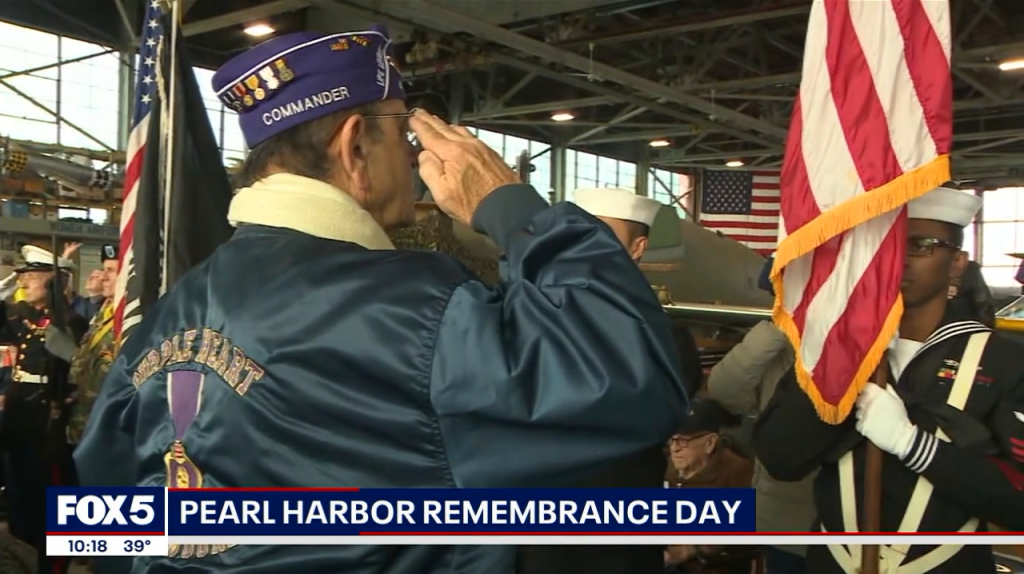
The American Airpower Museum and the Long Island Chapter of the Air Force Association remember the 82nd Anniversary of the Attack on Pearl Harbor, and honor WWII veterans in attendance.
Airpower Museum Honors WWII Veterans during December 7th, 82nd Anniversary Remembrance of the attack on Pearl Harbor as featured in Newsday
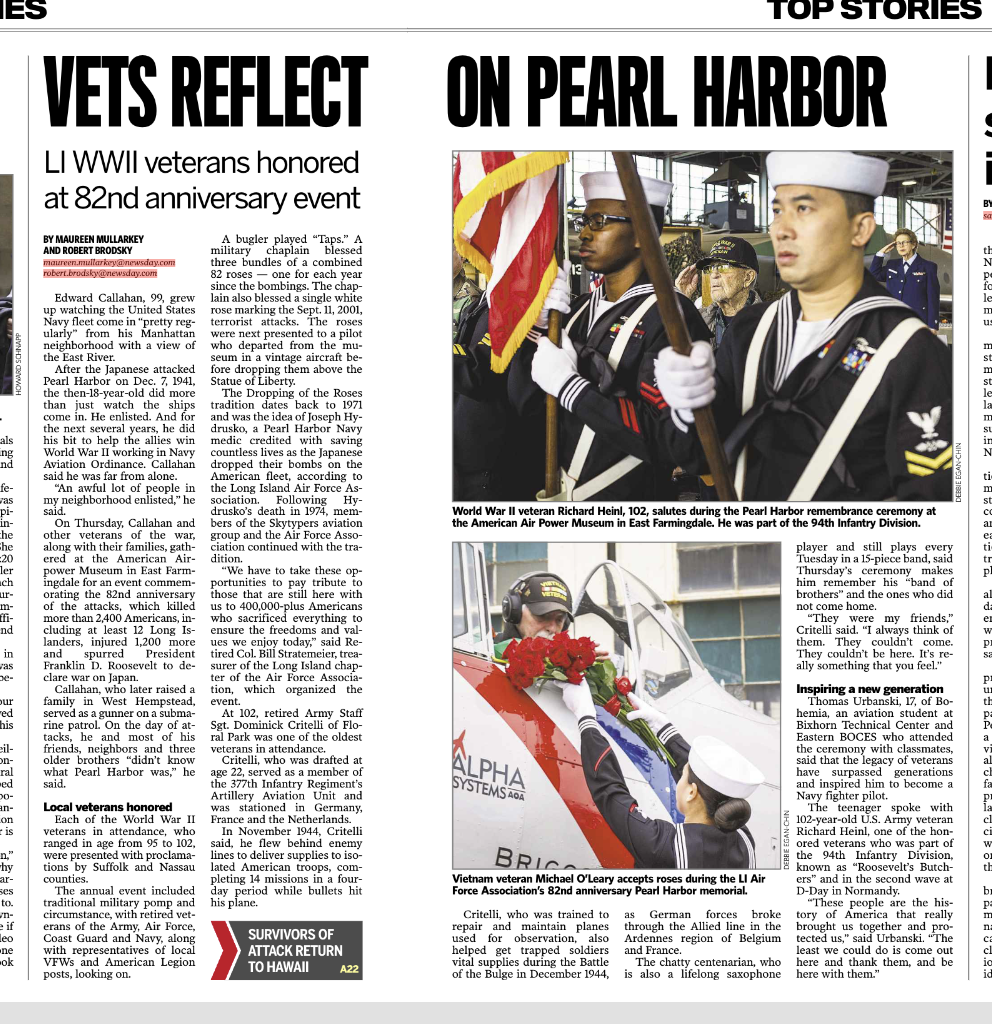
The American Airpower Museum 82nd Anniversary Remembrance of the attack on Pearl Harbor and dropping of the Roses Tribute as featured in Newsday.
WACO UPF-7
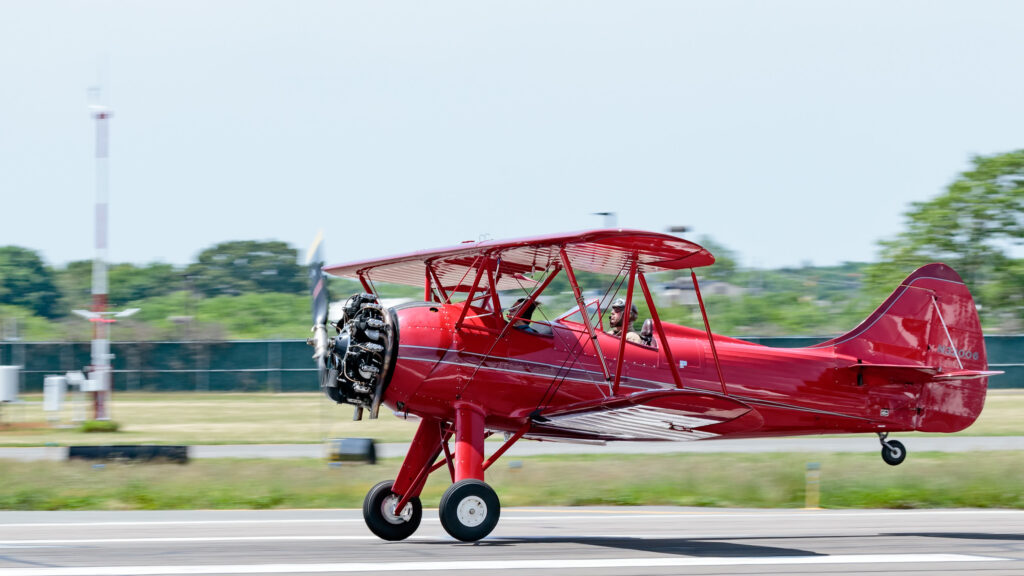
Aircraft: Waco UPF-7 Current Status: Flyable History: The Waco Aircraft Company (WACO) was an aircraft manufacturer located in Troy, Ohio, USA. Between 1919 and 1947, the company produced a wide range of civilian biplanes.The company initially started under the name Weaver Aircraft Company of Ohio but changed its name to the Waco Aircraft Company in 1928/29Waco’s history started in 1919 when businessmen Clayton J. Brukner and Elwood Junkin met barnstorming pilots Charley Meyers and George Weaver. Although their initial floatplane design was a failure, they went on to form the Waco company in 1920 and established themselves as producers of reliable, rugged planes that were popular with travelling businessmen, postal services, and explorers, especially after the company began producing closed-cabin biplane models after 1930 in addition to the open cockpit biplanes. During World War II, Waco produced large numbers of military gliders for the RAF and US Army Air Forces for airborne operations, especially during the Normandy Invasion and Operation Market Garden. The Waco CG-4 was the most numerous of their glider designs to be produced. At the same time Waco produced over 600 of its UPF-7 open biplanes and 21 VKS-7F cabin biplanes for the Civilian Pilot Training Program, which supplemented the output of the military training establishments. 42 privately-owned models of sixteen types were impressed into service as light transports and utility aircraft with the USAAF under the common designation C-72/UC-72. Production of commercial biplane trainers virtually ended in Depression years of the early 1930s, and new low-powered monoplanes rapidly took their place in the schools and in private aviation. Only the Army and Navy were principal customers for biplane trainers in succeeding years. While Waco did not have a share of this market, it was one of the few firms that continued to supply open cockpit biplanes to private owners of the mid-1930s, a group comprising what could be considered a custom trade. Yet the UPF-7, introduced in the late twilight of the biplane era, was built in greater quantity than any single Waco model that preceded it. Approximately 600 came out of the Troy, Ohio factory between 1937 and 1942. The UPF-7 was a continuation of the Waco “F” series which had been introduced with Model INF of 1930, a three-seater powered with a 100 hp Kinner K-5 engine. Other Fs in the series used a variety of engines up to 220 hp. The UPF-7 standardized on the 220 hp Continental W-670-6A, civil equivalent of Continental’s R-670 military engine. Its designation reflected the principal design characteristics of the airplane: the letter “U” identified the engine as the W-670, the “P” identified the wing and fuselage design, the “F” identified the model type or series. Details like landing gear and tail shape varied greatly through the series. While the UPF-7 was built in the largest numbers, there were limited other versions also built, mostly for special customers. These were known as LPF, VPF, YPF, and ZPF models. The only difference being the installation of different engines. Essentially a state-of-the-art refinement of the 1930 model, the UPF-7 retained its major features, particularly the heavily staggered wings with the strut-connected ailerons in upper and lower panels. The earlier Fs were all built as three-seaters, with two passengers seated side-by-side in the front cockpit. The UPF-7 was intended to be a dual-control trainer, but when the stick was removed, the front seat was wide enough to accommodate two passengers. In addition to the current nostalgic hobby activities, some UPF-7s are back in commercial operation at schools that teach aerobatics while others, thanks to two-seat front cockpits, hop paying passengers at air shows. Some are used for barnstorming in search of passengers. From the original 600, the total of Waco UPF-7s has decreased steadily. Today there are currentl about 150 in civil registery. About Our WACO UPF-7: The American Airpower Museum WACO UPF-7 is part of a private collection on loan to the museum. The WACO is currently on display, and also is one of the aircraft available for Flight Experiences at the museum through Spring, Summer, and Fall.
North American AT-6D “Texan”

Aircraft: North American AT-6D “Texan” Current Status: Flyable History: The North American Aviation T-6 Texan was an all-metal single-engine aircraft used to train pilots of the United States Army Air Forces, United States Navy, Royal Air Force, and other air forces of the British Commonwealth from the 1930s through the 1950s. Designed by North American Aviation, the T-6 is known by a variety of designations depending on the model and operating air force. The USAAC designated it as the AT-6, the United States Navy the SNJ, and British Commonwealth air forces, the Harvard, the name it is best known by outside of the United States. The Texan originated from the North American NA-16 prototype (first flown on April 1, 1935) which, modified as the NA-26, was submitted as an entry for a USAAC “Basic Combat” aircraft competition in March, 1937. The first model went into production and 180 were supplied to the USAAC as the BC-1 and 400 to the RAF as the Harvard I. The US Navy received 16 modified aircraft, designated the SNJ-1, and a further 61 as the SNJ-2 with a different engine. A total of 15,495 T-6s of all variants were built. During the Korean War and T-6s were pressed into service as forward air control aircraft. These aircraft were designated T-6 “Mosquitos. AT-6s would serve in the French, Portuguese, and the South African Air Forces seeing its last service in the South African Air Force in 1995. About Our North American AT-6 “Texans”: The American Airpower Museum Operates 2 AT-6Ds in its squadron of flyable aircraft. The Aircraft are the primary trainer, and proficiency aircraft for all warbird flight operations at the museum. The Museum also flies the AT-6s as part of its flight experience program offering Warbird Flights to the general public.
